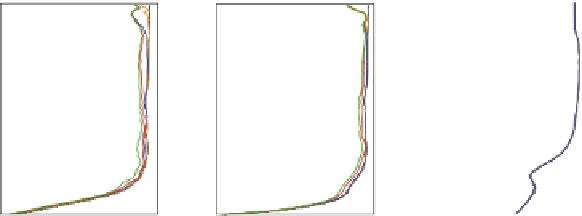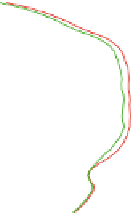Geoscience Reference
In-Depth Information
20
16
12
8
4
0
Temperature
U−wind
V−wind
Spec.humidity
Fig. 11.4
Global relative improvement [%] of the tangent-linear approximation for temperature,
wind and specific humidity coming from including: (a) dry physical parametrization schemes (i.e.
vertical diffusion, gravity wave drag, non-orographic gravity wave and radiation) alone (
grey bars
)
and (b) in combination with moist processes (i.e. convection and large-scale cloud parametrization
schemes -
black bars
) into the linearized model compared to the purely adiabatic tangent linear
model
a
b
c
S
p
ec
i
fic
hu
m
i
d
it
y
T
e
m
p
er
a
tu
r
e
Zonal wind
0
10
20
30
40
50
60
70
80
90
0
10
20
30
40
50
60
70
80
90
vertical diffusion − adiab
gravity wave drag − adiab
non−orog.grav.wave − adiab
radiation − adiab
large−scale cloud − adiab
convection − adiab
55
60
65
70
75
80
85
90
−90
−70
−50
−30
−10 0[%]
−140
−100−80 −60 −40 −20 0[%]
−100 −80
−60
−40
−20
0[%]
Fig. 11.5
Global relative error reduction of the tangent-linear (TL) model obtained from the
gradual inclusion of physical parameterizations as shown in legend with respect to adiabatic TL
model for (
a
) temperature, (
b
) zonal wind and (
c
) specific humidity. Relative errors of TL model
are computed with respect to finite differences using the full non-linear physics
parametrization schemes, e.g. by including moist processes on top of the dry
physical parametrization schemes.
11.6.2
Adjoint Sensitivities
Adjoint models can also be used for sensitivity studies since they allow to compute
the gradient of one output parameter of a numerical model with respect to all input
parameters. This property of adjoint allows to study, for instance, the sensitivity
of a physical parametrization scheme to its input parameters (e.g.
Li and Navon
1998
;
Janiskova and Morcrette 2005
). It is a more effective method compared with
other standard approaches of repetitively using the direct schemes to obtain the


































































































































































































Search WWH ::

Custom Search